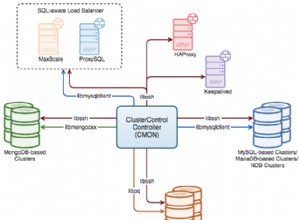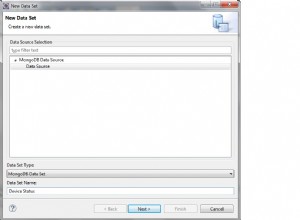Możesz użyć agregacji MongoBD, aby uzyskać pożądany wynik (Spójrz wygląd ):
db.health.aggregate([
{
$sort: {
"healths.effDate": 1
}
},
{
$group: {
_id: "$healths.healthCd",
healths: {
$first: "$healths"
}
}
},
{
$replaceRoot: {
newRoot: "$healths"
}
}
])
Implementacja wiosennego rozruchu
package com.example.demo;
import org.springframework.beans.factory.annotation.Autowired;
import org.springframework.boot.CommandLineRunner;
import org.springframework.boot.SpringApplication;
import org.springframework.boot.autoconfigure.SpringBootApplication;
import org.springframework.data.domain.Sort.Direction;
import org.springframework.data.mongodb.core.MongoTemplate;
import org.springframework.data.mongodb.core.aggregation.Aggregation;
import org.springframework.data.mongodb.core.aggregation.AggregationResults;
import com.google.gson.Gson;
import com.google.gson.GsonBuilder;
@SpringBootApplication
public class DemoApplication implements CommandLineRunner {
@Autowired
private MongoTemplate mongoTemplate;
public static void main(String[] args) {
SpringApplication.run(DemoApplication.class, args);
}
@Override
public void run(String... args) throws Exception {
// //If your operator is not available inside Aggregation or query is too complex,
// //use below code to write MongoDB shell code directly as JSON
// new AggregationOperation() {
//
// @Override
// public Document toDocument(AggregationOperationContext context) {
// return new Document("$group",
// new Document("_id", "$healths.healthCd")
// .append("healths", new Document("$first", "$healths")));
// }
//
// },
Aggregation agg = Aggregation.newAggregation(
Aggregation.sort(Direction.ASC, "healths.effDate"),
Aggregation.group("healths.healthCd").first("healths").as("healths"),
Aggregation.replaceRoot("healths")
);
AggregationResults<Healths> healths = mongoTemplate.aggregate(agg,
mongoTemplate.getCollectionName(Health.class), Healths.class);
for (Healths health : healths.getMappedResults()) {
Gson gson = new GsonBuilder().setPrettyPrinting().create();
System.out.println(gson.toJson(health));
}
}
}




